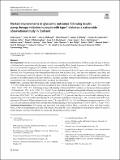Files in this item
Marked improvements in glycaemic outcomes following insulin pump therapy initiation in people with type 1 diabetes : a nationwide observational study in Scotland
Item metadata
| dc.contributor.author | on behalf of the Scottish Diabetes Research Network (SDRN) Epidemiology Group | |
| dc.contributor.author | Jeyam, Anita | |
| dc.contributor.author | Gibb, Fraser W. | |
| dc.contributor.author | McKnight, John A. | |
| dc.contributor.author | Kennon, Brian | |
| dc.contributor.author | O’Reilly, Joseph E. | |
| dc.contributor.author | Caparrotta, Thomas M. | |
| dc.contributor.author | Höhn, Andreas | |
| dc.contributor.author | McGurnaghan, Stuart J. | |
| dc.contributor.author | Blackbourn, Luke A. K. | |
| dc.contributor.author | Hatam, Sara | |
| dc.contributor.author | McCrimmon, Rory J. | |
| dc.contributor.author | Leese, Graham | |
| dc.contributor.author | Lindsay, Robert S. | |
| dc.contributor.author | Petrie, John | |
| dc.contributor.author | Chalmers, John | |
| dc.contributor.author | Philip, Sam | |
| dc.contributor.author | Wild, Sarah H. | |
| dc.contributor.author | Sattar, Naveed | |
| dc.contributor.author | McKeigue, Paul M. | |
| dc.contributor.author | Colhoun, Helen M. | |
| dc.date.accessioned | 2021-08-26T11:30:12Z | |
| dc.date.available | 2021-08-26T11:30:12Z | |
| dc.date.issued | 2021-06 | |
| dc.identifier | 275394460 | |
| dc.identifier | c3ef3989-f8b6-40dc-b14a-6c22994bacbe | |
| dc.identifier | 85102314413 | |
| dc.identifier.citation | on behalf of the Scottish Diabetes Research Network (SDRN) Epidemiology Group , Jeyam , A , Gibb , F W , McKnight , J A , Kennon , B , O’Reilly , J E , Caparrotta , T M , Höhn , A , McGurnaghan , S J , Blackbourn , L A K , Hatam , S , McCrimmon , R J , Leese , G , Lindsay , R S , Petrie , J , Chalmers , J , Philip , S , Wild , S H , Sattar , N , McKeigue , P M & Colhoun , H M 2021 , ' Marked improvements in glycaemic outcomes following insulin pump therapy initiation in people with type 1 diabetes : a nationwide observational study in Scotland ' , Diabetologia , vol. 64 , no. 6 , pp. 1320-1331 . https://doi.org/10.1007/s00125-021-05413-7 | en |
| dc.identifier.issn | 0012-186X | |
| dc.identifier.other | crossref: 10.1007/s00125-021-05413-7 | |
| dc.identifier.other | ORCID: /0000-0002-7170-1205/work/98488312 | |
| dc.identifier.uri | https://hdl.handle.net/10023/23842 | |
| dc.description | This study was supported by funding from Diabetes UK (17/0005627) and the Chief Scientist Office (ref. ETM/47). | en |
| dc.description.abstract | Aims/hypothesis Our aim was to assess the use of continuous subcutaneous insulin infusion (CSII) in people with type 1 diabetes in Scotland and its association with glycaemic control, as measured by HbA1c levels, frequency of diabetic ketoacidosis (DKA) and severe hospitalised hypoglycaemia (SHH), overall and stratified by baseline HbA1c. Methods We included 4684 individuals with type 1 diabetes from the national Scottish register, who commenced CSII between 2004 and 2019. We presented crude within-person differences from baseline HbA1c over time since initiation, crude DKA and SHH event-rates pre-/post-CSII exposure. We then used mixed models to assess the significance of CSII exposure, taking into account: (1) the diffuse nature of the intervention (i.e. structured education often precedes initiation); (2) repeated within-person measurements; and (3) background time-trends occurring pre-intervention. Results HbA1c decreased after CSII initiation, with a median within-person change of −5.5 mmol/mol (IQR −12.0, 0.0) (−0.5% [IQR −1.1, 0.0]). Within-person changes were most substantial in those with the highest baseline HbA1c, with median −21.0 mmol/mol (−30.0, −11.0) (−1.9% [−2.7, −1.0]) change in those with a baseline >84 mmol/mol (9.8%) within a year of exposure, that was sustained: −19.0 mmol/mol (−27.6, −6.5) (−1.7% [−2.5, −0.6]) at ≥5 years. Statistical significance and magnitude of change were supported by the mixed models results. The crude DKA event-rate was significantly lower in post-CSII person-time compared with pre-CSII person-time: 49.6 events (95% CI 46.3, 53.1) per 1000 person-years vs 67.9 (64.1, 71.9); rate ratio from Bayesian mixed models adjusting for pre-exposure trend: 0.61 (95% credible interval [CrI] 0.47, 0.77; posterior probability of reduction pp = 1.00). The crude overall SHH event-rate in post-CSII vs pre-CSII person-time was also lower: 17.8 events (95% CI 15.8, 19.9) per 1000 person-years post-exposure vs 25.8 (23.5, 28.3) pre-exposure; rate ratio from Bayesian mixed models adjusting for pre-exposure trend: 0.67 (95% CrI 0.45, 1.01; pp = 0.97). Conclusions/interpretation CSII therapy was associated with marked falls in HbA1c especially in those with high baseline HbA1c. CSII was independently associated with reduced DKA and SHH rates. CSII appears to be an effective option for intensive insulin therapy in people with diabetes for improving suboptimal glycaemic control. | |
| dc.format.extent | 12 | |
| dc.format.extent | 1002089 | |
| dc.language.iso | eng | |
| dc.relation.ispartof | Diabetologia | en |
| dc.subject | Diabetes mellitus type 1 | en |
| dc.subject | HbA1c | en |
| dc.subject | Hypoglycaemia | en |
| dc.subject | Insulin pump | en |
| dc.subject | Ketoacidosis | en |
| dc.subject | RA0421 Public health. Hygiene. Preventive Medicine | en |
| dc.subject | E-DAS | en |
| dc.subject | SDG 3 - Good Health and Well-being | en |
| dc.subject.lcc | RA0421 | en |
| dc.title | Marked improvements in glycaemic outcomes following insulin pump therapy initiation in people with type 1 diabetes : a nationwide observational study in Scotland | en |
| dc.type | Journal article | en |
| dc.contributor.institution | University of St Andrews. School of Geography & Sustainable Development | en |
| dc.contributor.institution | University of St Andrews. School of Medicine | en |
| dc.identifier.doi | 10.1007/s00125-021-05413-7 | |
| dc.description.status | Peer reviewed | en |
This item appears in the following Collection(s)
Items in the St Andrews Research Repository are protected by copyright, with all rights reserved, unless otherwise indicated.

